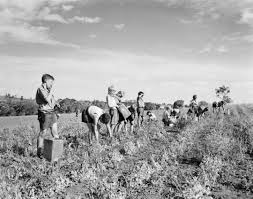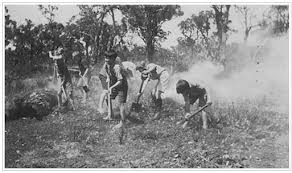
Contact: Fairbridge: website: www.fairbridge.org.uk ; email: info@fairbridge.org.uk
http://fairbridgecanada.com
Kingsley Ogilvie Fairbridge, founder of the Society for the Furtherance of Child Emigration to the Colonies – which became the Child Emigration Society and then finally the Fairbridge Society, was born on May 5, 1885 in South Africa.
At the age of 11, the family moved to Rhodesia, which is now known as Zimbabwe. This ended his formal education. Fairbridge took up Market Gardening and in 1903, visited his grandmother in England for about a year. The poverty and malnourishment in the London slums were like night and day compared to the under-populated open space of Rhodesia.
On his return, Fairbridge worked for two and a half years for a Mr Freeman who was recruiting locals to work in gold mines near Johannesburg.
He applied for a Rhodes scholarship and upon his fourth attempt at passing the entrance examinations, was accepted at Exeter College, Oxford University.
At a meeting at the Colonial Club at Oxford, a group of university associates formed themselves into the Society for the Furtherance of Child Emigration to the Colonies, which later became the Fairbridge Society. The next two years were spent trying to interest people in the project and raising funds. He obtained a diploma in Forestry in 1911, and in December of that year married a former nurse, Ruby Ethel Whitmore, who had been helping him for some time.

In March 1912, the Fairbridges sailed for Western Australia and arrived in Albany, Western Australia.
After several months of searching for suitable properties around Western Australia the Fairbridges found a property in Pinjarra, Western Australia.The Australian government agreed to pay $12.00 for each child towards the cost of passage.
After cleaning up the property, as well as building accommodation (mainly tents), the first party of 13 boys, aged between 7 and 13, arrived on board the Australind in January, 1913. In July, a second party of 22 boys arrived.
 During the First World War there was very little support from the British Government and so, in August, 1919, Fairbridge went to England and raised almost $50,000 for the development of the school though public donations and the British Government’s Overseas Settlement Committee, on condition that the Western Australian Government continued its grant of six shillings per week per child.
During the First World War there was very little support from the British Government and so, in August, 1919, Fairbridge went to England and raised almost $50,000 for the development of the school though public donations and the British Government’s Overseas Settlement Committee, on condition that the Western Australian Government continued its grant of six shillings per week per child.
With the grant, a larger property of 3,200 acres of land was purchased north of Pinjarra and new buildings, including cottages to house the children, a dining hall, a house for Fairbridge’s own family and farm buildings, were erected.
Fairbridge had suffered from malaria for many years and was generally in ill-health. He died at the age of 39 on 19 July, 1924, in Perth, Western Australia, while recovering from a minor operation. He was buried at Pinjarra At the time of his death, 200 children were at the school, and enrolment gradually reached 400.
Kingsley Fairbridge had hoped originally to open a farm school in Canada. Ten years after his death in an appeal that was led by the Prince of Wales and encouraged by Canadian enthusiasts, was made to help bring the farm school concept to the Dominion. Sufficient funds were raised to purchase a 1,100 acre site at Cowichan Station, near Duncan, on Vancouver Island. The new facility – officially named The Prince of Wales Fairbridge Farm School – opened in 1935.
 The Farm School was made up of fourteen cottages, each capable of supporting twelve children and a “cottage mother”. The other buildings included a chapel, a hospital, and a school. These facilities – which were adjacent to the school’s large dairy farm – were maintained with the help of donations from England and a grant from the British Columbia government.
The Farm School was made up of fourteen cottages, each capable of supporting twelve children and a “cottage mother”. The other buildings included a chapel, a hospital, and a school. These facilities – which were adjacent to the school’s large dairy farm – were maintained with the help of donations from England and a grant from the British Columbia government.
In 1938, a 2,000 acre orchard near Vernon was donated to the Fairbridge Society by Captain J.C. Dun-Waters. Named the Fintry Fairbridge Training Farm, the Okanagan property had over three hundred children pass through it.
Five other schools were established by the Fairbridge Society. They included Northcote Farm School, Bacchus Marsh, Victoria in 1937 and the Molong Fairbridge Farm School, New South Wales in 1938 and the Rhodesia Fairbridge Memorial College, Southern Rhodesia, in 1946.
 Institutionalized child care was also beginning to be questioned and the passing of the 1948 Child Welfare Act in Britain (which made local governments responsible for child care) made child migration redundant. The last party of children arrived in Canada in 1948.
Institutionalized child care was also beginning to be questioned and the passing of the 1948 Child Welfare Act in Britain (which made local governments responsible for child care) made child migration redundant. The last party of children arrived in Canada in 1948.
In British Columbia, the Fintry estate was sold and in the early 1950s, the last of the Fairbridge children left the Prince of Wales Farm School.
By the 1970s, only the original school at Pinjarra was operating and in 1981,it closed its doors. Almost two thousand children had come to Pinjarra and were housed under the scheme between 1913 and 1981.
The isolated, rural Fairbridge Farm School near Moolong in New South Wales operated from 1938 until 1974 during which time about 1000 boys and girls passed through the school and were trained to be “farmers and farmers’ wives”.
Contact: Fairbridge: website: www.fairbridge.org.uk ; email: info@fairbridge.org.uk
